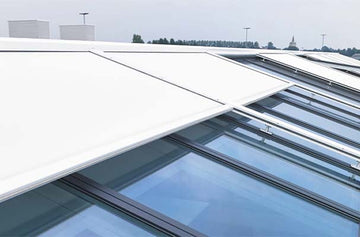
Find out professional tricks and features to make your skylight 100 percent waterproof. Quality Glass Fittings will educate you on the use of T-sections made of skylight, seals, and the right way of installing them.
The significance of Skylight Waterproofing.
A skylight is a touch of grace and natural light to any area however, it comes with one main tricky structural problem, which is water proofing. Even a skylight that is well designed may turn out to be an expensive source of water sounds and leakages unless effectively sealed.
The need of a waterproof skylight cannot be overemphasized in the UK where unpredictable weather is a common phenomenon. Having the right materials, design and installation, such as the high grade of skylight T-section profiles, seals and accessories, you are free to enjoy all the advantages of skylight lighting without the fear of leaks.
Quality Glass Fittings offers quality, weather-proofed skylight panels that have been highly customized to suit the UK conditions to guarantee extended functionality and shield against moisture.
Materials and Components for a Leak-Free Skylight
To build a leak-resistant skylight system, every component must work together to form a durable, watertight assembly. Here are the essential parts you’ll need — all available at Quality Glass Fittings.

1. Skylight T‑Section Profiles
Our SKY LIGHT – T‑SECTION profiles are precision-engineered to hold multiple glass panels in place while providing a sealed connection that prevents water ingress. The T‑profile maintains glass alignment, channels water away from joints, and resists movement from wind or temperature shifts.
2. EPDM / Rubber Seals and Gaskets
Flexible sealing materials like neoprene, EPDM rubber, and silicone gaskets are essential to absorb shock and seal gaps. These materials resist weathering, UV exposure, and temperature changes, maintaining a strong seal over time.
3. Corner Cleats & Brackets
Our TSI‑1 corner cleats and TSI‑2 cleats help secure the corners and joints of the skylight frame, ensuring structural stability and preventing movement that could weaken seals.
4. Fasteners & Connectors
Use rust-resistant, high-tension screws or bolts compatible with your profile type. Always pair fasteners with rubber washers or gaskets to prevent penetration points for water.
5. Neutral-Cure Silicone Sealant
All final joints between glass panels and frames should be sealed with neutral-cure silicone. This ensures chemical compatibility with rubber components and a flexible, waterproof seal.
read more: How to Stop Shower Door Leaks
Appropriate installation protocols.
Skylight sealing depends not only on the materials to be used but also on the installation. The following is the way to have it right with the skylight systems at Quality Glass Fittings:

Align T Sections Precisely
Make sure that every T section is flat and firmly fixed then put in the glass panels. Weak sealing and uneven pressure are caused by a misalignment.
Compress Seals Evenly
Glass needs to be pressed into seals with a consistent and even pressure not forced. Excessive compression may deflate the seal creating holes.
Install Compatible Cleats and Brackets.
Join the frame joints on our suggested polishing cleats and spacers. This strengthens construction and discourages settlement which may deteriorate the waterproofing.
Apply Flashing Smartly
At the intersection between the skylight and the roofing system, flashing should be in excess and move away water near the glazing. Close every opening with silicone of high grade.
Fill Joints with Silicone
With the glass and profiles installed, seal all the contact sides with neutral-cure silicone to provide a complete waterproof ensuring moisture is not allowed in.
Final Pressure Test
Pour controlled water across the unit before classifying the job as completed and inspect interior surfaces to check whether there is any leakage or not.
Common Skylight Waterproofing Mistakes to Avoid
Skylights are an excellent way to bring natural light into a space, but poor waterproofing can lead to costly issues. Here are some of the most common skylight waterproofing mistakes and how to prevent them:
Incorrect Profile Sizing
Using the wrong profile—especially a T-section that doesn't match the glass thickness—can result in loose fittings and uneven seal pressure. This compromises the integrity of the waterproofing system.
Improper Gasket Installation
Gaskets that are twisted, misaligned, or poorly fitted create vulnerable areas where water can easily penetrate, particularly under wind pressure or heavy rain.
Missing Cleats or Brackets
Structural support components like cleats and brackets are essential. Without them, skylight panels can shift over time, weakening seals and breaking the waterproof barrier.
Overreliance on Sealant
Silicone sealant is a helpful supplement—but not a substitute—for mechanical sealing. Relying solely on sealant instead of proper profile sealing invites long-term leakage problems.
Lack of Expansion Gaps
Thermal expansion is a natural occurrence. Failing to leave adequate spacing can cause glass or frames to warp, leading to cracked seals and potential leaks.
Skylight Maintenance Tips for Long-Term Waterproof Protection
Maintaining your skylight isn’t just about cleanliness—it’s about protecting your property from water ingress and preserving structural integrity. Here are five expert-recommended maintenance practices to keep your glass roof waterproofing system performing at its best:
1. Clean Seals Every 3–6 Months
Gently wipe seals using a soft cloth and a non-abrasive cleaner. Removing dust, debris, and algae buildup helps maintain seal flexibility and prevents edge deterioration.
2. Inspect After Severe Weather
Following storms or heavy rainfall, examine the skylight interior for signs of water streaks, condensation, or damp spots. Early detection can prevent more serious water damage and structural issues.
3. Re-Tighten Cleats Annually
Seasonal temperature shifts and natural vibrations can loosen structural components. Re-check and tighten brackets, and ensure gaskets are properly seated to maintain waterproof integrity.
4. Replace Aged or Damaged Seals
5. Monitor Perimeter Flashing
Flashing plays a key role in directing water away from vulnerable areas. Regularly inspect it for separations, warping, or water pooling, and reseal if necessary.
Final Thoughts
Achieving a truly waterproof skylight goes beyond sealant—it requires precision-engineered parts and meticulous installation. At Quality Glass Fittings, our skylight T-sections, cleats, gaskets, and accessories are built to withstand the UK’s challenging climate.
Whether retrofitting or starting fresh, trust our skylight waterproofing solutions to deliver reliability, longevity, and peace of mind.
FAQs:
Q1: What’s the best way to waterproof a skylight?
A complete waterproof system includes T-section profiles, high-quality EPDM or neoprene seals, silicone joints, and properly installed flashing. All components are available at Quality Glass Fittings to ensure long-lasting protection.
Q2: How can I tell if my skylight is leaking?
Common signs include water stains on ceilings or walls, peeling paint, dampness near the skylight frame, or visible condensation after rainfall.
Q3: Can I replace just the seal on a skylight?
Absolutely. If the skylight’s structure is intact, replacing aged or damaged seals from our collection can quickly restore its waterproof performance.
Q4: How often should skylight seals be inspected?
We recommend inspecting seals every 6 to 12 months and always after extreme weather. Look for loss of compression, cracks, or signs of wear.
Q5: Are your T-section profiles compatible with triple glazing?
Yes, our skylight profiles are offered in a range of dimensions to suit single, double, and certain triple-glazed panels. For custom needs, please contact our support team for tailored recommendations.

